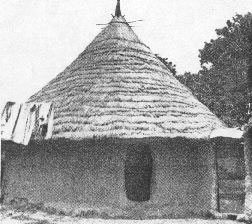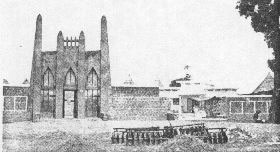| History of
Kankan
Kankan is a town of approximately
25.000 inhabitants, which extends on the left river of Milo, on a surface
of almost 2.500 hectares.
Its situation of hinged slab
of High-Guinea and the attraction of Cheick-Sherif and Mohamed Fanta
Mahdy made a city of it where the originating ones in all the French and
foreign African territories are elbowed.
The autochtones are tradesmen
and farmers. Before the opening of the roads Zérékoré-Monrovia
and Kissidougou-Dabola, Kankan was the metropolis of the conveyors. The
craftsmen, in particular the workers in ivory and the jewellers, are many
and prosperous there.
KANKAN: Capital of
High-Guinea, it is the second town of Guinea from the point of view of
the importance. It has been just set up in Commune of full exercise.
Its urban equipment continues (roadway system, water conveyance, electrification,
etc).
Terminus of the railroad Conakry-Niger, Kankan shelters a military
camp and its airfield is equipped. Like all towns of its row, it has its
schools, its medical formations, its churches, its markets, its sports
grounds, etc...
The Administration,trade
and European elements start to build rather significant buildings there.
In their turn, the populations gradually replace their straw dormittories
by houses into hard sheet glazes. (see proof photos). By putting at the
shelter many fire damages during the dry season, that improves the conditions
of hygiene, and habitability. But the means available to these populations
are limited and it would be desirable that the Real estate company of Guinea
thanks to which Conakry changes, extends its action more to it.
With the origin,
the town of Kankan was a village in the north of the river under the baobab
trees with the current site of the Inspection of the Administrative Businesses,
upstream of the bridge [ on the Milo river ]. It was founded approximately
300 years ago by Malinké Mory (Malinké-Marabouts) of Sarakolé
race and whose ancestor, Abdouramane Kaba or Mouramani, would have come
from Diafounou close to Nioro (Sudan French, today the Republic of Mali).
This ancestor settled in Diankana (village which is approximately 20 kilometers
from Kankan on the road of Siguiri, where he was joined later by his sister
Mariamagbe Kaba, Holy called upon nowadays. The descendants of Abdouramane
Kaba founded the village of Bankalan (approximately 28 kilometers from
Kankan on the road of Siguiri) from where one of them, Daouda Kaba, created
a hamlet of culture to supply his brother Fodé Mamadouba Kaba.
This brother had advised to him to make his lougan upstream village on
Milo to be able to easily descend harvest on the river. Apart from the
periods of culture and harvest Daouda was constantly occupied cutting the
kind of reed called "Malinké" Kan or "Xan-Xan" who pushes
in the plain of the rivers and with which one braids the "secco" closing
of the door of the dormitories. Domestic hedges and other uses are also
made of them. It is of that Kankan, then hamlet of culture, would have
drawn its name. Later, a Marabout, Kabadinè called Kabinè
(future M'Bemba Alpha Kabinè) reading in the future asked for to
his elder brothers the authorization of going to settle with his talibés
in a place not very far away from the borough. It created a small hamlet
there. Little time afterwards, he was joined by his close relations
and, gained by the charms of the place and under the hidden power of the
future Saint Man, people everywhere had just enlarged the small agglomeration.
This one was not long in extending until reaching the village. A Mosque
was built close to the dormitory of the Founder of the new village. This
dormitory exists nowadays in the West of the Mosque in rebuilding.
The Marabout Mbemba Kabadinè , entirely devoted to Islamism,
did not want to marry. One day, it revealed that he would not have a child
and that the future generations of the City would be regarded as his descent.
It is for that each one in the Malinké countries called him later
"M'Bemba" (my ancestor or my Grandfather). With its death, "MBemba" was
buried according to his last wills, in the small cemetery of the village,
close to the tomb of his elder brother, with the site which he had chosen.
An unknown tree pushed on his tomb. When the inhabitants said that
this tree was a "Doubalé". an authentic "Doubalé" pushed
near his feet. One then believed that it was a "Séré", at
once a truth "Séré" led to 5 meters. Its sheets and
its fruits did not leave any doubt about its dissimilarity with the first
tree. But the "Doubalé" as the "Séré" constituted
the underwood of the crowned tree and not one their sheets did not still
try to pass through, nor beside the foliage of the protective tree. All
their foliages are directed towards the West as by the hand of a clever
man. With 10 meters of the crowned tree a beautiful "Ninkon pushed" (exotic
plum tree) on the tomb of Karamo Sidiki, the father of the Sheik Mohamed
Chérif. Currently a wall of stone, at the same time imposing andelegant,
surrounds the tree crowned on a surface of 40 side meters. This wall, high
by approximately 2 meters, is surmounted pieces of broken bottle to prevent
the climbing of the kids attracted by the fruits of Ninkon. The door
of entry, with majestic and original leaves, is obligingly opened to the
visitors by the Conservative of the place.
Daouda Kaba, had an only son named Fodé Mamoudouba Kaba called
"Fode Toman", which, in Malinké, wants to say homonymous of Fode
(Fode Mamoudouba). Fode Toman
had in his turn four boys whose descendants gave rise to the four current
districts of Kankan:
1.Timboda, which draws its
name from Timbo, residence of Almamy of Fouta,
who maintained good relations with Kaba of Kankan, in particular
with :
a- Alpha Kabine Kaba
b- Manfing Kaba grandfather of famous Karamoko Talibi "Indigenous
Mayor"
of Kankan nowadays.
c- Alpha Mamoudou Kaba,
father of Karamoko Mory Kaba, a Saint-man died in
1916 and grandfather of the current Head
of the Canton of Baté, Alama
Amadou Kaba.
2- Kabada, probably
souvenir of Kaba, last Capital of the empire of Mali on
Niger
in Sudan
3- Banankoroda (under the cheesemonger)
4- Salamanida: Near
the pool (pond) of Salamani , which was in the east of the
city.
When Kankan was besieged
by the troops of Almamy Samory, Karamoko Dai Kaba, one of sons of Alfa
Mamoudou , went to the front in Ségou, and the city was occupied
by the French Army in 1891.
With the religious point
of view, Kankan owes its current radiation in Cheick Mohamed Chérif
called "the Sherif". The Sherif, dead on September 8, 1955, was certainly
of his time the most popular Marabout and more venerated of Guinea and
the close Territories. His ancestor, Sherif Lamine, an Arab, camefrom
Mauritania to visit to the local Marabouts by propagating the litanies
of "Qadria". His son, Alkaly Mahamoud, was versed in legal sciences and
provided of this fact the functions of judge Kankan. It is probably of
him that Rene Caillié mentioned in his relation travel to Tombouctou.
His son, Karamoko Sidiki, married in Samatikya (Ivory Coast) named Fanta,
which was to give the day to Mohamed Chérif called Fanta-Mady or
Mamadi, son of Fanta) whose holiness appeared about 1922. Then, he had
a great maraboutic influence which attracted to him, of the close countries,
the students and many visitors. Those carried much gifts to him:
horses, money, gold, carpets, clothes, etc... that he distributed at once
in his environment. He was a virtuous man , charitable, liked brotherhood.
In his prayers, he always blessed France which he always regarded as
the best of the nations. With his death he was buried in the dormitory
where he was collected every day. His concession, to which the street of
the Mosque on the Southern side leads, is recognized by a monumental gate
of the Eastern style. His children grouped around their elder brother El
Hadj Sidiki Chérif and devote themselves to Islamism. His spiritual
succession is not yet assured. According to the old ones, the town of Kankan
will shelter always simultaneously two saints: one, which will present
the signs external of Holiness the other remaining hidden, in accordance
with this malinké proverb: "a mountain is not seen behind the other".
These Saints can be families other than those their predecessors. Some
time after the death of the first, the second must necessarily appear.
It is what currently awaited in Kankan.
Cheick Mohamed Chérif
carried a regret: that not to have been able to complete the rebuilding
of the Mosque. All the faithful ones, all the Friends of the Islam and
all admirateurs of the Sherif must contribute to the completion of this
Mosque which, from the point of view of architecture and because of its
dimensions, would not have its similar in Africa. |


